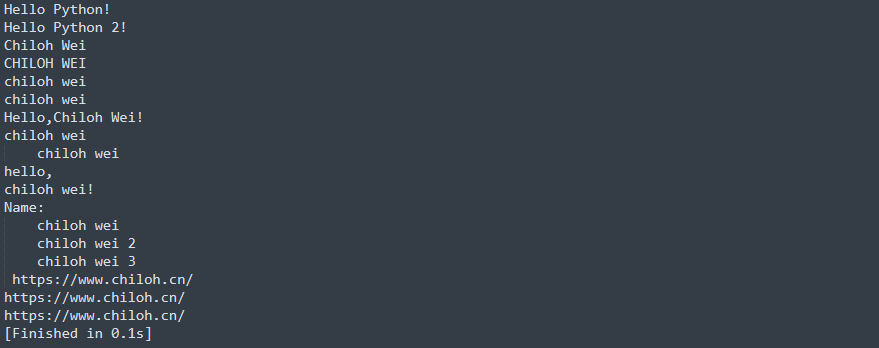Python 3 学习记录:字符串
Categories: Tech
Python是一种跨平台的计算机程序设计语言,是一个高层次的结合了解释性、编译性、互动性和面向对象的脚本语言。在博客中,我将陆续记录我的Python学习过程,这是第一篇,Python 3 学习记录(一):字符串。
一、代码及呈现
代码:
# 输出字符串
message = "Hello Python!"
print(message)
message2 = "Hello Python 2!"
print(message2)
# 字符串大小写修改
name = "chiloh wei"
print(name.title()) # 首字母大写
print(name.upper()) # 字母全部大写
print(name.lower()) # 字母全部小写
# 字符串合并(拼接)
firstname = "chiloh"
lastname = "wei"
fullname = firstname + " " + lastname
print(fullname)
print("Hello," + fullname.title() + "!")
# 制表符/换行符
print("chiloh wei")
print("\tchiloh wei") # 制表符: \t
print("hello,\nchiloh wei!") # 换行符: \n
print("Name:\n\tchiloh wei\n\tchiloh wei 2\n\tchiloh wei 3")
# 删除空白
text = " https://blog.chiloh.cn/ "
website = text.rstrip() # 删除字符串后面空白
website2 = text.lstrip() # 删除字符串前面空白
website3 = text.strip() # 删除字符串两端空白
print(website)
print(website2)
print(website3)
呈现:

二、课后练习题
题目一:
将用户的姓名存到一个变量中,并向该用户显示一条消息。显示的消息应非常简单,如:“Hello Eric, would you like to learn some Python today?”。
代码实现:
name = "Eric"
message = "Hello " + name.title() + ", would you like to learn some Python today?"
print(message)
题目二:
将一个人名存储到一个变量中,再以小写、大写和首字母大写的方式显示这个人名。
代码实现:
myname = "chiloh wei"
print(myname.lower()) # 人名小写
print(myname.upper()) # 人名大写
print(myname.title()) # 人名首字母大写
题目三:
找一句你钦佩的名人名言,将这个名人的姓名和他的名言打印出来。输出应类似于下面这样(包括引号):
Albert Einstein once said, "A person who never made a mistake never tried anything new."
代码实现:
person = "Albert Einstein"
print(person.title() + 'once said, "A person who never made a mistake never tried anything new."')
题目四:
重复题目三,但将名人的姓名存储在变量
famous_person中,再创建要显示的消息,并将其存储在变量message中,然后打印这条消息。
代码实现:
famous_person = "Albert Einstein"
message = famous_person.title() + 'once said, "A person who never made a mistake never tried anything new."'
print(message)
题目五:
存储一个人名,并在其开头和末尾都包含一些空白字符,务必至少使用字符组合“\t”和“\n”各一次。打印这个人名,以显示其开头和末尾的空白。然后,分别使用剔除函数
lstrip()、rstrip()和strip()对人名进行处理,并将结果打印出来。
代码实现:
person_name = "\tHis Name:\n\t\tSteven Paul Jobs\n"
print(person_name)
print(person_name.lstrip()) # 剔除开头空白
print(person_name.rstrip()) # 剔除末尾空白
print(person_name.strip()) # 剔除两端空白

